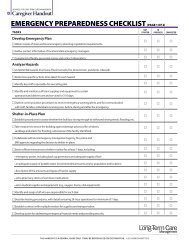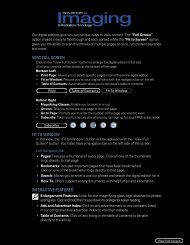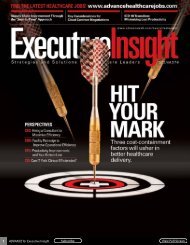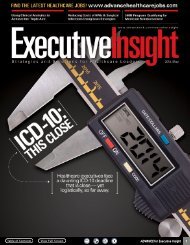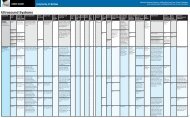ADVANCE for Executive Insight 1 ADVANCE for Executive Insight
ADVANCE for Executive Insight 1 ADVANCE for Executive Insight
ADVANCE for Executive Insight 1 ADVANCE for Executive Insight
- No tags were found...
Create successful ePaper yourself
Turn your PDF publications into a flip-book with our unique Google optimized e-Paper software.
inventory management<br />
Operational<br />
Cost Creep<br />
Consistent inventory management is critical to avoid<br />
unnecessary expenses. By Michael Jones<br />
Michael Jones is on staff at<br />
<strong>ADVANCE</strong>.<br />
There are any number of additional expenses<br />
in a healthcare facility that seem small<br />
in relation to the overall budget, but can<br />
become substantial in the long run. These factors<br />
have to be kept in check—by the varying<br />
departments and by employees on the individual<br />
scale—to cut down on unnecessary costs. In a<br />
recent interview, Joe Skochdopole, CCE, senior<br />
director of operations support at TriMedx, provided<br />
some insight into potentially costly habits<br />
a facility can develop over time and what can be<br />
done to avoid cost creep.<br />
“I believe the appropriate approach is, ‘how do<br />
we maximize what we have be<strong>for</strong>e we talk about<br />
cutting quality?’” said Skochdopole. “There are<br />
so many efficiency and waste issues in healthcare<br />
that I don’t think we have to reduce quality in any<br />
way, shape or <strong>for</strong>m.”<br />
Skochdopole presented three factors in particular<br />
that can cause cost creep in a facility,<br />
which include:<br />
n The extra fees and expenses that occur after<br />
the initial payment is made on medical devices,<br />
consumable pieces<br />
n Extra capital spending in departments, such<br />
as software and hardware updates, service<br />
charges and enhancements<br />
n The importance of standardization<br />
A common problem in hospitals, clinics and<br />
other healthcare institutions is an abundance<br />
of medical devices and machines, all from<br />
different manufacturers that require specific<br />
parts. Due to this lack of standardization and<br />
the varying accessibility of medical equipment,<br />
facilities end up overspending on maintenance<br />
costs alone.<br />
“Manufacturers are trying to figure out how<br />
to increase their revenue streams,” continued<br />
Skochdopole pointedly. “How do they stay competitive<br />
from an acquisition standpoint, but continue<br />
to keep revenue coming into them <strong>for</strong> the<br />
life of that device?”<br />
Early Action<br />
To be successful at cutting down on cost creep<br />
expenses, it has to be started early in lifecycle<br />
management and implemented facility-wide via<br />
policies and regulations as well as on the individual<br />
level. Skochdopole noted on the need <strong>for</strong><br />
early action, citing preventive measures like the<br />
development of cross-functional committees to<br />
monitor the purchasing of medical devices<br />
A common problem<br />
in hospitals, clinics<br />
and other healthcare<br />
institutions is an abundance<br />
of medical devices<br />
and machines,<br />
all from different manufacturers<br />
that require<br />
specific parts.<br />
% cost/revenue<br />
cost “creep”<br />
cost-cutting exercise<br />
target<br />
time<br />
<strong>ADVANCE</strong> <strong>for</strong> <strong>Executive</strong> <strong>Insight</strong><br />
35



